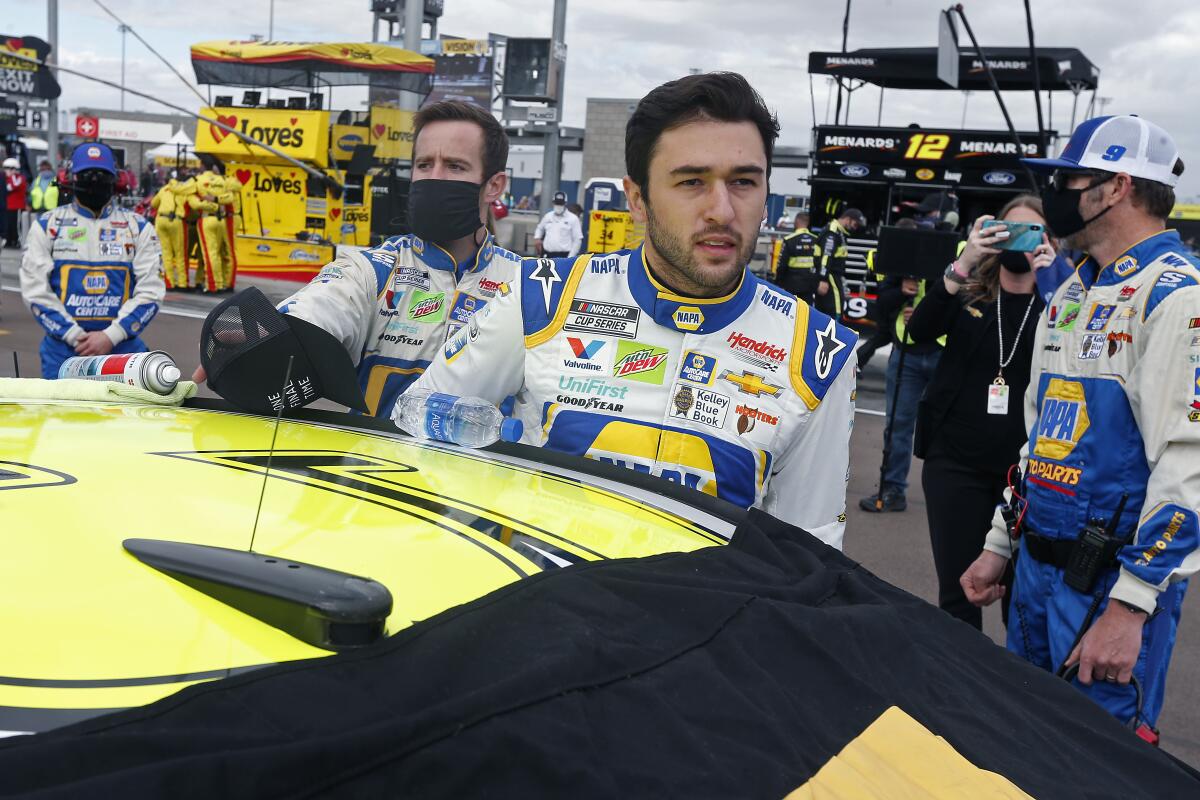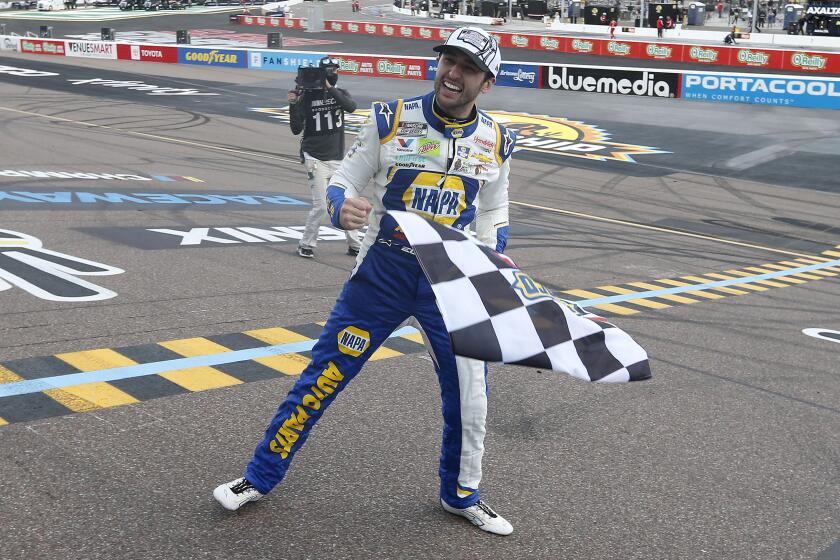NASCAR navigated season finale by crowning a rising star as champion

- Share via
AVONDALE, Ariz. — Drivers, finally, stop your engines.
NASCAR has waved the checkered flag on its frenetic 2020 season, a whirlwind of rescheduled and relocated races, some held with lots of fans, some fans and no fans at all. The effort to complete all 38 races during the pandemic was rewarded with a new champion, who just happens to be NASCAR’s reigning most popular driver.
Chase Elliott won three of the final five races, including Sunday’s winner-take-all finale at Phoenix Raceway, to claim the first Cup of his career. His late-season surge upstaged Kevin Harvick and Denny Hamlin, the two most dominant drivers this year, and elevated the second-generation NASCAR star alongside his Hall of Fame father as NASCAR champions.
It was a promising close for NASCAR, which very much needs its young stars in the spotlight. Dale Earnhardt Jr. was a 12-time winner of the fan-selected most popular driver award but never won a championship. Elliott took the reins in 2018 after Earnhardt retired and rewarded his loyalists in just his fifth full season at NASCAR’s top level.
He has faced quixotic expectations since he was 14 — that’s when Rick Hendrick gave him a driver development contract — from peers who saw his heritage as a means to re-energizing a sport that saw its biggest stars trickle out of the driver’s seat the last five years. Jeff Gordon, Tony Stewart, Carl Edwards and Earnhardt have all retired, and seven-time champion Jimmie Johnson joined the group Sunday.
Elliott’s instant popularity was ordained not for what he did in his Chevrolet, but for his racing family tree that harkens back to a NASCAR a generation of fans still yearn for even though the sport has modernized. Bill Elliott won the 1988 Cup title, 44 races and fans voted “Awesome Bill from Dawsonville” the most popular driver a record 16 times.
He would have kept winning the award, too, but Bill Elliott in 2001 removed his name from the ballot and encouraged fans to honor his late rival, Dale Earnhardt Sr.
Chase Elliott, who turns 25 later this month and is NASCAR’s third-youngest champion, is very much like his dad: soft-spoken outside of the car, calm and calculated behind the wheel. The family has never left its Georgia hometown of Dawnsonville — a small town of less than 3,000 people an hour outside of Atlanta — and they still sound the siren at the local pool hall whenever an Elliott wins.
When Harvick was asked in 2017 what NASCAR needed to re-energize its base, he pointed directly to Elliott.
“NASCAR needs Chase Elliott to win,” Harvick said. “Chase Elliott is the tie to the traditional NASCAR fan. It’s the only shot they’ve got with the traditional NASCAR fan. His dad, the history and heritage of the sport, there isn’t anybody else in the lineup that I can think of.”
Chase Elliott raced from the back of the field after his car failed pre-race inspection to win at Phoenix Raceway and his first NASCAR Cup championship.
He’s won now. And at the same time, NASCAR seems to have stabilized.
The series for at least a decade has been adjusting to an ever-changing economic landscape, an aging fan base, declining television ratings and attendance, and a dearth of star power. When the pandemic put NASCAR on a 10-week pause in March, the series could have collapsed.
Instead, NASCAR was one of the first sports to resume competition, first to get fans back into the stands and first to complete its entire schedule. A new car originally scheduled for 2021 was postponed a year, but expectations of the car improving the business model has ignited interest among new team owners.
NASCAR President Steve Phelps called 2020 “the single most difficult year that we’ve faced as a sport,“ but a year in which the industry unified to keep cars on the track. Next year’s season-opening Daytona 500 is still on schedule for Feb. 14 and plans now include spectators in the stands.
Uncertainty hangs over everything, but Phelps said NASCAR is in good shape.
“Will everyone’s bottom line look more challenged? The answer is yes. Do I believe we as a sport are going to shut down? We are not,” Phelps said. “Are we financially viable to move forward? We are. We are going to persevere and we are going to continue to put on races, bring that great racing to the fan base.”
Two of NASCAR’s three championships at Phoenix were won in dramatic late shootouts and of the three new champions, Elliott is the oldest. Truck Series champion Sheldon Creed is 23; Xfinity Series winner Austin Cindric is 22.
In Elliott, NASCAR’s most popular driver is also the champion for the first time since Bill Elliott’s 1988 title. He’s far from charismatic but has a Southern charm with all his “heck,” “dang” and “shoot” exclamations that resonates with the sport.
The Cup solidifies his spot as the new face of NASCAR, of Hendrick Motorsports and of Chevrolet. But Elliott is humble, just like his dad, and not interested in labels.
“I don’t know that that’s really for me to say who is or isn’t the face of something,” he said. “But from where I sit, it’s the performance industry, right? It’s entertainment from the outside looking in, but what makes my living is performing or not.
“I think me performing at a high level is going to take me a lot further in life than being the face of something.”
More to Read
Go beyond the scoreboard
Get the latest on L.A.'s teams in the daily Sports Report newsletter.
You may occasionally receive promotional content from the Los Angeles Times.











